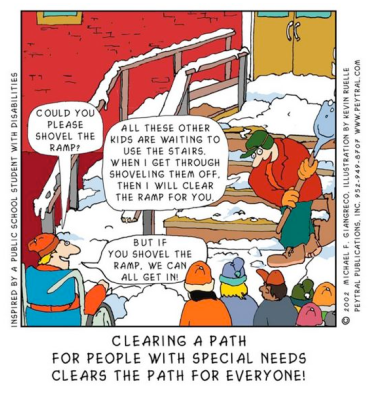This article is also available in: 日本語
Hi,
The topic of Ability For Success this month is “Society and Disability? The Future of Social Win-Win Strategy.” We are lucky to have a guest, who works with one of the fortune 500 companies in Japan, and a grad student in the U.S. joining us.
We started the discussion with an inspiring picture.

According to one article*1 World Bank published, there are 15 percentage of the world population experienced some form of disability. With this said, majority of the world population is able-bodied people. As a result, most infrastructures and rules are made based able-bodied world standard. I am sure the staff in the picture does not have discrimination agains people with mobility impairment. He just did what he thinks is the best for the majority of the group. He thinks clearing the snow on the stairways so most children can enter the building. He did not see clearing the snow on the ramp would allow every one enter the building. This happens every day everywhere. Most people think ramp is only for wheelchair users.
We broke down this lesson to the following components and wonder if we can observe similar outcome in different settings:
- Issue – snow on the path
- Tool – school staff, shovel
- Secret sauce – different mindset
- Better outcome – every body can enter the building

Interestingly, all the participants today have a lot of things to say about trains.
Yusuke said the audio announcement of a train staff can be difficult to catch sometimes even for people with no hearing impairment. It is extremely useful to him that some trains in Japan have screens set up in the cars to display important information of the route. The screen does not only benefit general public but also people with hearing impairment. It is also very useful for foreigner. The screen in a Japanese train car often display information in Japanese, English, Chinese and Korean.
Annie said that the train she uses regularly in New Jersey does not open all the car doors when stopping at a station. It is difficult for her and other elder passengers to move quickly from the waiting room to the car where the door is opened. It would be much better and easier for all passenger if the train company can consider to open all car doors at each station.
Mizuki shared her experience of taking trains in Tokyo. In Tokyo, Most trains’ entrance step is taller than platform so it is dangerous to get on and off a train without a ramp. Mizuki, as a Moon Rider (wheelchair user) usually asks train staffs to set up the ramp so she can board the train safely. However, waiting for the staff to check train schedule and setting up the ramp prolongs her commute time. She usually need more time to commute compared to other able-bodied people.
There is one line in Tokyo, which is called Oeido Line, is accessible for moon riders. Its car entrance is about as tall as the platform so it is safe to get on and off without someone setting up the ramp. If all trains can adopt this system, it would not only make commute easier for moon riders but also for elder people and people with strollers.
To be continued.
Reference:
*01: Number of people experienced disability: http://www.worldbank.org/en/topic/disability/overview
